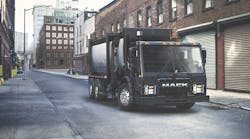Mack Trucks, Greensboro, N.C., announced plans at this year’s Waste Expo to have a fully electric Mack LR refuse model equipped with an integrated Mack electric drivetrain operating in North America in 2019. The New York City Department of Sanitation (DSNY), one of Mack’s largest customers, will test the demonstration vehicle in its highly demanding operations.
“The fully electric Mack LR model will feature an electric motor feeding power through a two-speed transmission and a propeller shaft to the rear axles,” explains Curtis Dorwart, refuse product manager at Mack Trucks. “All accessory power needs—including the hydraulics—will be driven on demand by auxiliary motors with power supplied by the truck’s lithium-ion batteries.” This continues a growing trend in mobile hydraulics to drive a machine’s hydraulic pump with a variable-speed electric motor, thereby transmitting only that power needed for the task at hand—with zero power consumption while the hydraulic system is idle.
Companies and municipalities have been experimenting with hybrid hydraulic drives in refuse trucks for a few years, now. With hydraulic hybrid drives, the trucks use a mechanical drive train for high-speed travel. However, the frequent starts and stops while collecting refuse on a route lends itself to hydraulics, because hydraulic dynamic braking captures the energy to decelerate these heavy vehicles and regenerates the energy when to accelerate the vehicle to its next stop.
Mack officials believe that a fully electric vehicle will deliver the most value within a closed-loop application, in which the truck returns home every night, such as refuse collection. Benefits of fully electric trucks include zero emissions, significantly reduced noise, and environmental sustainability. The ability to operate quietly at night is particularly attractive to refuse customers in urban areas.
“It’s clear that electromobility will be a part of the trucking industry’s future, and Mack is well-positioned to offer integrated, fully electric solutions for the North American market,” says Jonathan Randall, senior vice president of sales and marketing for Mack Trucks North America. “DSNY is one of Mack’s largest customers, and the department is known for its progressive sustainability efforts. We look forward to working with them as we test the first fully electric LR model in a real-world application.”
“The New York City DSNY looks forward to extending our long-standing partnership with Mack Trucks through the testing of the electric LR,” adds Rocky DiRico, New York City DSNY deputy commissioner. “Sustainability is extremely important to the DSNY, and we consistently test new technology to help New York City reach its goal of 80% reduced emissions by 2050.”


